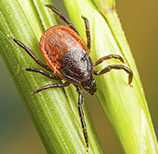According to the CDC, the incidence of Lyme disease in humans is much higher than in previous years— with cases of tickborne diseases having doubled from 2004 to 2016, from 22,000 to 48,000, and Lyme disease accounting for 82 percent of tickborne diseases.
What is Lyme disease?
First described in 1975 the disease was first identified in Lyme, CT which gave it its name. The disease is caused by a bacteria (spirochete) called Borellia burgdorferi which is transmitted by a tick bite. The type of tick involved in the spread of the disease is called Ixodes spp. which feeds on animals at all stages of its life (larvae, nymph, adult).
How does Lyme disease spread?
Immature ticks become infected when they feed on infected rodents. The organism is then transmitted to a second host when the nymph or adult tick feeds. Ixodes scapularis and Ixodes pacificus feed on deer. Expanding ranges of deer herds have resulted in an increased distribution of infected ticks.
Subsequently, when the nymph or adult tick attaches to a new host and feeds, the infective organism is deposited at the site of attachment over a period of hours. The organism thus infects the new host be it a dog or a human.
Even though the vector tick is called the deer tick, its feeding habits are not restricted to deer. They also feed on dogs and so are frequently in close proximity to people who have dogs. There is no evidence that Lyme disease can spread directly from dogs to humans. However, the same type of tick that could infect a dog can also feed on people. There is a potential for humans to be infected due to the fact that we tend to spend time in the same places as our dogs do If our dogs are picking up ticks, we certainly could be as well.
When are people likely to be affected by Lyme disease?
In a 2011 CDC study, it was determined that there is a definite association between the incidence of canine infections and human infections. CAPC reports some of the findings from that study:
- "Human Lyme disease incidence was effectively zero when the canine seroprevalence was <1.3 percent."
- "Among 14 states with canine seroprevalence >5 percent, median annual human Lyme disease incidence was about 100-fold higher (24.1 cases/100,000 population) and positively correlated with canine seroprevalence."
In other words, in places where Lyme is more common in dogs it’s also more common in people.
Dogs in endemic areas should be tested yearly. A positive test demonstrates that vector ticks may be present and have the ability to transmit disease to humans. Aggressive tick prevention and control should be practiced everywhere but particularly in areas where these diseases have been demonstrated to exist. Vaccination for Lyme disease is more controversial, but many experts recommend vaccination especially in Lyme endemic areas.
Symptoms of Lyme disease
According to the Mayo Clinic, clinical signs of Lyme disease in humans can differ drastically and tend to affect more than one body system: Click here for a list of symptoms.
How can I protect myself and my dog from Lyme disease?
- In environments that support ticks, year round tick control should be practiced. Talk to your veterinarian about Lyme vaccination for your dog and remember to test each year.
- Check yourself and your pets closely if there’s a chance that any of you may have been exposed to ticks.
- For people, if a tick bite is associated with a rash see your physician right away. Early therapy does much to prevent clinical disease.
If you have any questions or concerns, you should always visit or call your veterinarian -- they are your best resource to ensure the health and well-being of your pets.
Beware the Bug Ticks 101 By Dr. Ruth MacPeteTicks are more than just creepy; they can spread a number of different diseases that affect both pets and people. You’ve just read about Lyme disease; now learn about the others. Read more> Or learn more about dogs and parasites > |

